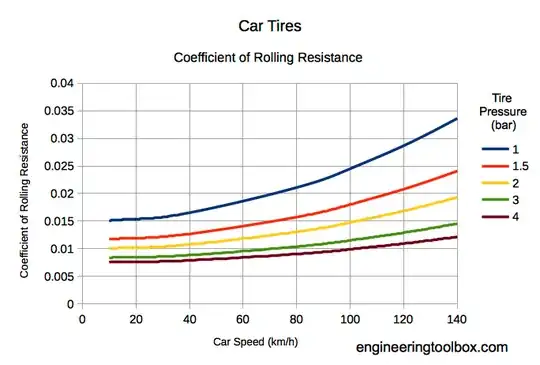Of course you can calculate that. Heat of combustion per fuel 1 $\textrm{kg}$ must be equals to work done by resistance forces :
$$ E_{_\textrm{HOC}} \eta = F l = (F_{_R} + F_{_D}) l $$
Substituting for rolling resistance $F_{_R}$ and air drag $F_{_D}$ forces and solving equation for $l$ gives :
$$ l = \frac{E_{_\textrm{HOC}} \eta}{C_{rr}mg+0.5\rho v^2 C_D A} $$
Here :
- $l$ - car distance traveled by burning 1 kg of fuel
- $E_{_\textrm{HOC}}$ - fuel heat of combustion, substituted in Joules per 1 kg
- $\eta$ - fuel heat conversion efficiency to car kinetic energy (never 100%, depends on engine effectivity, etc)
- $C_{rr}$ - dimensionless rolling resistance coefficient (depends on tires, check in tires manufacturer)
- $m$ - car mass in kg
- $g$ - gravity constant
- $\rho$ - density of the air ($\textrm{kg}/m^3$)
- $v$ - car average speed
- $C_D$ - dimensionless drag coefficient
- $A$ - car cross sectional area, perpendicular to car speed vector
Estimation
Let's evaluate this formula for "typical diesel car" :
- $E_{_{HOC}} (\textrm{LHV value}) = 4.34\cdot10^7 \textrm{J}$ for Diesel
- $\eta$ = 0.5 (however most iron engines have only 37%, so it's boosted to maximum)
- $C_{rr} = 0.015$ (in car running at 100km/h speed and with tires at 2 bars pressure)
Coefficient of rolling resistance is a function of car speed :

- $m = 1710 \textrm{kg}$ (BMW 7 Series (E65), mass lower bound)
- $g = 9.8 {m/s^2}$
- $\rho_{air} = 1.225 \textrm{kg}/m^3$
- $v = 27.7 m/s \space$ (100 km/h)
- $C_D = 0.31$ (BMW 7 Series, 2009)
- $A = 1.902 m \times 1.492m = 2.837 m^2$ (BMW 7 Series (E65) width*height)
Putting all these numbers into equation given above, results in :
$$ 32\space527 m = 32.5km $$
which you can drive with $1 kg \approx 1.129 \textrm{liters}$ of diesel
Comparison with real fuel consumption
BMW 7 Series (E65) can drive $12.2km$ with 1 liter of diesel. That's about $2.4$ times less than predicted theoretical limit. That may be partly, because it's very hard to construct highly effective engines. Also not all fuel combustion useful energy is converted to car kinetic energy. Some of it may be transferred to accumulator which in turn powers all car electronic devices, such as - GPS navigation, on-board computer, parking system, autopilot control, electronic stability program, etc. In nowadays car is not just "box pushed forward by engine", it's far more complicated system. And I predict that for the future power consumption will raise even more, because systems tends to become more-complex. We already can see this trend from the raising power consumption of cell phone battery. In nowadays typical cell phone keeps battery energy for 1-2 days, while in good-old times battery energy was enough for 1 week+.
